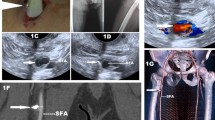Abstract
Mineral foreign bodies (stones) are infrequent findings in clinical and radiological practice. However, a growing number of reports indicate that they raise clinical and diagnostic concern in ophthalmology, neurosurgery, maxillofacial surgery, otolaryngology, gastroenterology, and vascular surgery. Dense finding in the soft tissue without clear history of foreign body penetration may represent diagnostic challenge mimicking calcifications or bony fragments. The aim of this work is to analyze the appearance of stone foreign bodies on radiographs and computed tomography. A collection of minerals and rocks was used for analysis. The clinical case of a stony foreign body which penetrated into the soft tissue of the leg is used to demonstrate the diagnostic challenge and management. Available literature describing imaging characteristics of stones was reviewed. The results of this work will help in diagnostic interpretation and assessment of stone foreign body composition.



Similar content being viewed by others
References
Aras MH, Miloglu O, Barutcugil C, Kantarci M, Ozcan E, Harorli A (2010) Comparison of the sensitivity for detecting foreign bodies among conventional plain radiography, computed tomography and ultrasonography. Dentomaxillofac Radiol 39:72–78
Thach AB, Ward TP, Dick JS 2nd et al (2005) Intraocular foreign body injuries during Operation Iraqi Freedom. Ophthalmology 112:1829–1833
Secer HI, Gonul E, Izci Y (2007) Head injuries due to landmines. Acta Neurochir (Wien) 149:777–781
Allott R, Naylor AR (2007) A chip off the old block! Eur J Vasc Endovasc Surg 33:668–669
Türkçüoğlu P, Aydoğan S (2006) Intracranial foreign body in a globe-perforating injury. Can J Ophthalmol 41:504–505
Dass AB, Ferrone PJ, Chu YR, Esposito M, Gray L (2001) Sensitivity of spiral computed tomography scanning for detecting intraocular foreign bodies. Ophthalmology 108:2326–2328
Arnáiz J, Marco de Lucas E, Piedra T et al (2006) Intralenticular intraocular foreign body after stone impact: CT and US findings. Emerg Radiol 12:237–239
Lakits A, Prokesch R, Scholda C, Bankier A (1999) Orbital helical computed tomography in the diagnosis and management of eye trauma. Ophthalmology 106:2330–2335
Kiymaz N, Yilmaz N (2005) Penetrating intracranial stone. Pediatr Neurosurg 41:145–147
Balak N, Aslan B, Serefhan A, Elmaci I (2009) Intracranial retained stone after depressed skull fracture: problems in the initial diagnosis. Am J Forensic Med Pathol 30:198–200
Oikarinen KS, Nieminen TM, Mäkäräinen H, Pyhtinen J (1993) Visibility of foreign bodies in soft tissue in plain radiographs, computed tomography, magnetic resonance imaging, and ultrasound. An in vitro study. Int J Oral Maxillofac Surg 22:119–124
McDermott M, Branstetter BF 4th, Escott EJ (2008) What's in your mouth? The CT appearance of comestible intraoral foreign bodies. AJNR Am J Neuroradiol 29:1552–1555
Endican S, Garap JP, Dubey SP (2006) Ear, nose and throat foreign bodies in Melanesian children: an analysis of 1037 cases. Int J Pediatr Otorhinolaryngol 70:1539–1545
Seo JK (1999) Endoscopic management of gastrointestinal foreign bodies in children. Indian J Pediatr 66:S75–S80
Pabiszczak M, Szyfter W, Golusinski W (2003) A case of an uncommon foreign body in the esophagus. Otolaryngol Pol 57:747–750
Han S, Kayhan B, Dural K, Koçer B, Sakinci U (2005) A new and safe technique for removing cervical esophageal foreign body. Turk J Gastroenterol 16:108–110
Trommer G, Kösling S, Nerkelun S, Gosch D, Klöppel R (1997) [Detection of orbital foreign bodies by CT: are plain radiographs of foreign bodies still useful?]. Rofo 166:487–492 [Article in German]
Author information
Authors and Affiliations
Corresponding author
Rights and permissions
About this article
Cite this article
Maizlin, Z.V., Vos, P.M., Lee, A. et al. Stone foreign body—radiographic and CT appearance. Emerg Radiol 19, 317–322 (2012). https://doi.org/10.1007/s10140-012-1031-6
Received:
Accepted:
Published:
Issue Date:
DOI: https://doi.org/10.1007/s10140-012-1031-6




